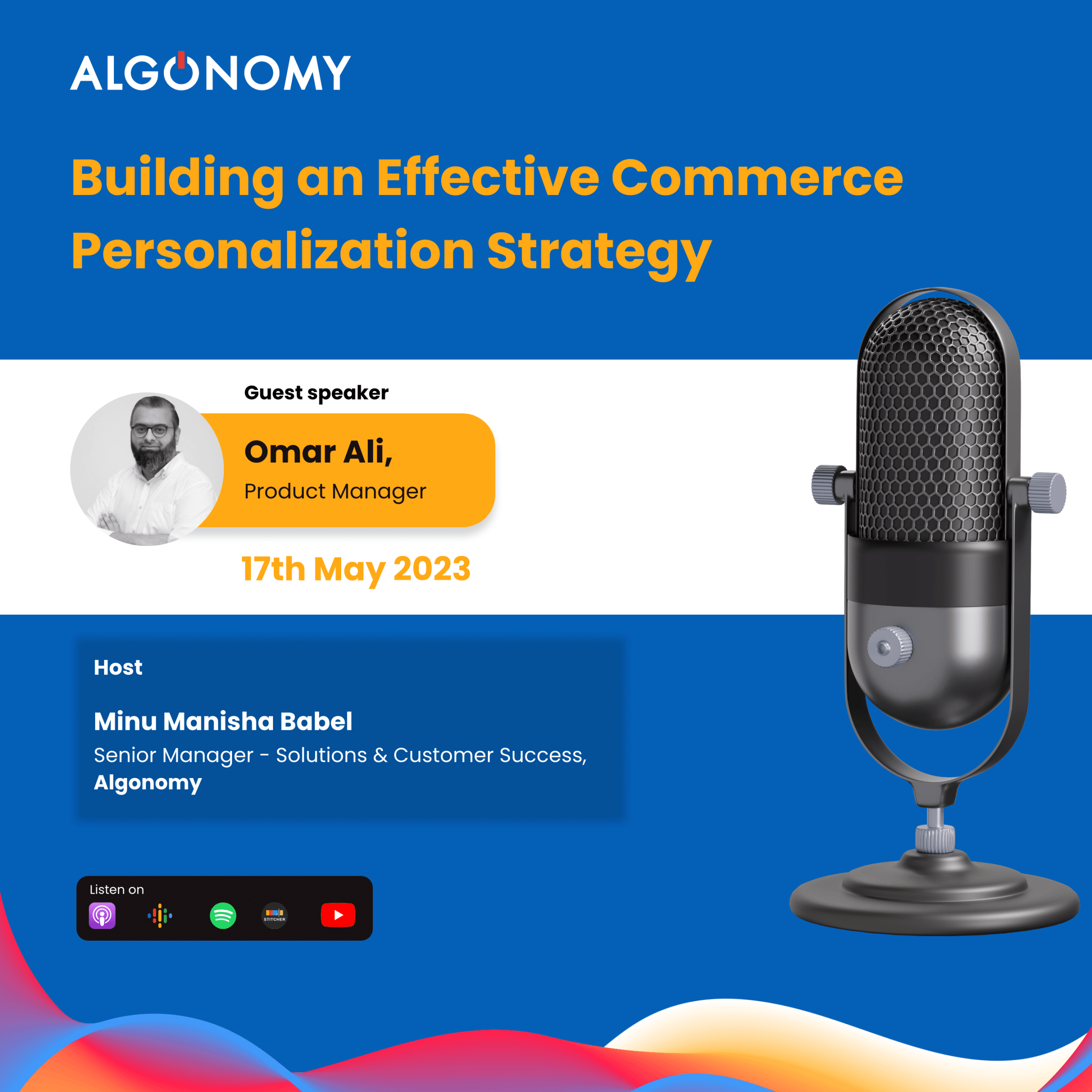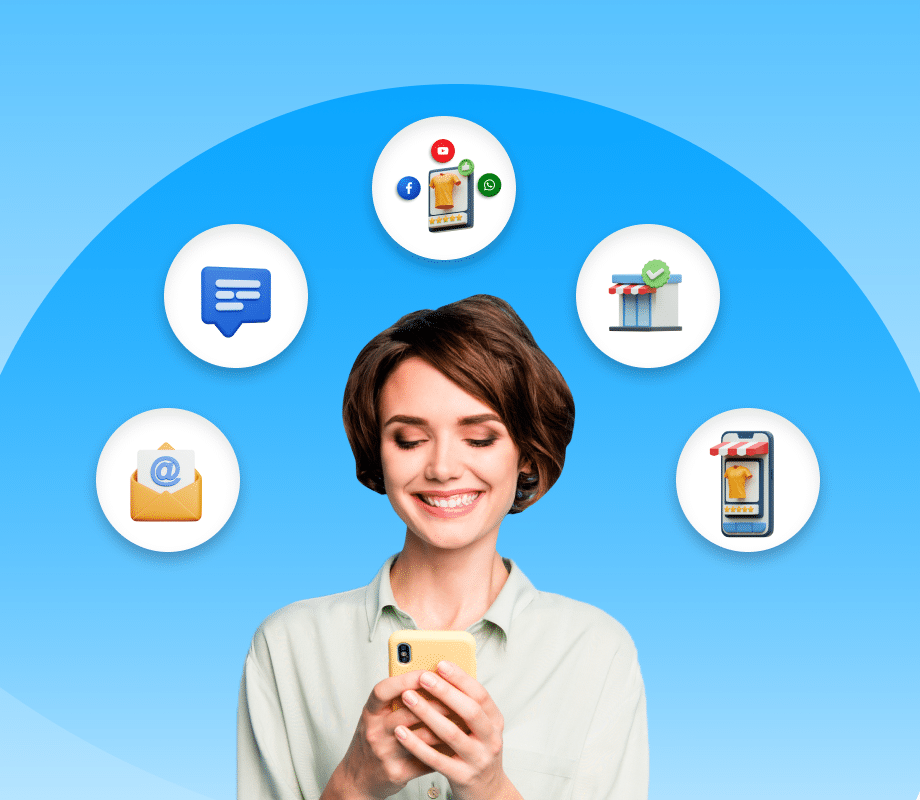Our Latest Episodes

View transcript
×
0:00 The average consumer now carries out at least two transactions online each day.
0:06 Amazed.
0:06 Well, we have some more such fascinating facts coming up.
0:10 Hello, everyone.
0:12 Welcome to the retail story, a podcast series that explores how technology is transforming retail from both the business and consumer perspectives.
0:23 Each episode in this series will feature conversations with technology leaders and domain experts who would talk about challenges retailers face and ways to address them some new and emerging trends in the industry and the digital strategies that retailers are implementing today to win customers and stay ahead of the game.
0:46 I am your host, Milo Manisha Babil and today I have with me Mr Omar Ali from Middle East.
0:54 Omar is a seasoned product management professional.
0:57 He has over 16 years of work experience in creating digital consumer experiences that translate to higher engagement, loyalty and revenue.
1:08 He’s an expert at developing web mobile platform and I O T.
1:13 Thank you so much Mr Romer and welcome to the podcast.
1:17 It is great to have you and looking forward to an insightful conversation today.
1:22 Thank you so much for having me, Mino.
1:24 It’s a pleasure to be a part of the podcast.
1:26 Awesome.
1:27 Thanks to begin our conversation.
1:30 I’d like to ask.
1:31 could you please tell me a bit more about your background experiences and what excites you the most about retail and the digital customer experience space?
1:43 Yeah, sure.
1:45 so I’ve been working in the digital space for over a decade now.
1:50 I started my career being a customer service agent.
1:54 then e-commerce was, was always a point of interest to me.
2:00 And from there, I naturally evolved into being a product manager because I wanted to own things, the ones that I was working on.
2:11 So, and now I’m actually a full time product manager running e-commerce products.
2:18 I’ve been working in various industries including B to B, Ecommerce, travel, automotive, classified E government.
2:26 And now I’m in, in retail.
2:29 the thing that excites me the most is like this space where I work.
2:35 It’s, it’s just like it’s, it’s constantly getting innovations.
2:41 There is an evolution of technology with, with evolution, it comes with, with new opportunities, new opportunities to meet customer needs and exceed their expectations.
2:54 And what interests me the most is the intersection of data with technology and C X in general and how we as you know, organizations or, or product people can leverage that data to drive growth and customer loyalty.
3:16 Awesome, awesome.
3:19 just discussing about like a current state we just entered a new financial year.
3:24 So what how according to you, you know, is the state of retail specifically in 2023?
3:34 Yeah.
3:34 So retail this time around like it, it, it has multiple challenges like given all the geopolitical scenarios that are happening.
3:45 but it also comes up with, with, with so many opportunities that, you know, that were not offered earlier.
3:52 digitally.
3:54 we feel that you know, more retail companies are now opting for personalization experiences.
4:06 They are now, you know, the customers of o of all such products are expecting personalized experiences across all touch points from the discovery to purchase and beyond.
4:20 Just to summarize this customers now have multiple options.
4:25 And what they’re looking for is a simpler solution that can fulfill their needs.
4:34 like it, it’s like it, it can come down to any, any shopping app that you see out there.
4:41 And, and I, I feel like the companies who are, who are unable to prioritize personalization, they are like on, on the risk of losing customers to competitors who are, you know, providing more tailored experiences.
4:58 So, yeah, I feel personalization is, is where, you know, I feel most of the of, of the retail digital organizations are moving to in 2023 that’s where the focus is going to be very true.
5:14 I I do agree, like from discovery to purchase and beyond, it’s a very competitive market and yes, the customers are spoiled for choice.
5:24 So what does it take to acquire and retain customers today?
5:29 And how can the retailers grow their customer base in this intensively competitive market?
5:37 Yes, you’re right.
5:38 So like, as you earlier said, like these days, like retail market is intensely competitive.
5:48 and in order to acquire customers and retain customers, we have to present them with personalized experiences.
5:59 And it’s, it’s, it’s getting increasingly important now by personal experiences.
6:04 I mean, we need to, you know, like companies need to enable the teams to leverage customer data.
6:14 look at advanced analytics.
6:17 see how can you know, the personalized experiences that you’re creating are meeting customer needs or even ex exceeding those needs at times.
6:28 I can, I can call an example here, like for example, recommending a product based on customer past purchases seems to be quite simple.
6:36 But understanding based on the frequency of a certain product that a customer has bought and then recommending that might add another value and that would exceed customers expectation when they are, you know, coming back to the platform to buy the same product.
6:52 So, so just by accumulating customers past purchase data, looking at their browsing history, we can increase the chances of you know, improving customer satisfaction which would directly impact to the overall N P s.
7:09 And you know, the these recommendations would also help retailers to stand out in a, in a, in a very crowded and competitive market out there because at the end of the day, you are looking to build some sort of a brand loyalty, right?
7:25 And any, any, any retailer, any, any, any such company that is prioritizing personalization would be better positioned to succeed in acquiring and retaining customers in the long run.
7:37 Very true, very true.
7:38 So like you mentioned about leveraging customer data and you know, the advanced analytics and how we move from data silos to organized and classified data to maybe stitched across, you know, platforms.
7:52 And so much more like when we talk about data.
7:54 So what types of data do you think are essential to personalize commerce experiences?
8:01 And what is the role of A I machine learning in enabling that kind of personalization?
8:09 Yes, I I guess there are multiple touch points.
8:12 I guess retailers must collect and analyze data of customers including their demographics such as their age, their gender location along with, with past purchases through browsing and preferences wherever those are collected.
8:31 It is only by analyzing such data.
8:35 and you can only by analyzing such data, you can you know pre detailed customer profiles which would then help the business better understand their customers and anticipate their needs.
8:47 And to just do all of this, I guess A I is, is, is the way forward.
8:54 So A I N M L machine learning technologies are critical to such analysis and, and processing of, of such vast amount of customer data.
9:03 And, and, and there are, there are multiple algorithms that you know, that can help you come up with, with certain analysis on how to make use of that data in, in, in the right way.
9:16 Right.
9:16 Right.
9:18 Very true.
9:19 Coming back to like different stages of a customer journey.
9:24 how can retailers deliver personalization at you know, the exploration stage, decision stage, purchase stage or even beyond like loyalty and all and how can A I M L power this like even further?
9:42 So I, I would say retailers you know, can so it comes down to the customer data again.
9:48 If, if, if we begin with the exploration stage over there, I I guess retailers can start by, by recommending certain content based on customers previous history or, or the demographics as we spoke earlier.
10:03 because this stage the customer is just exploring the products and, and the services offered by the retailer that they’re just exploding and not, not performing a things just do start to get a little interesting when they are in the decision stage, that’s where customers are kind of expecting more, more relevant product recommendations or, or personalization algorithms to chip in.
10:30 and even then even on the decision stage, there are times when, when we feel that the customers are a bit in indecisive at this stage.
10:39 So, and when we know that, you know that they’re, they’re falling, that they’re actually following a certain path on, on the funnel.
10:47 We, at that point of time, certain product recommendation of certain content actually boosts their decision making capability and in, you know, make them a paying customer or help them purchase a certain item or just, you know, increase the chances of a purchase.
11:08 that, that’s, I, I guess, is, is, is important in, in the decision stage.
11:13 If you look at the purchase stage, I think that’s, that’s one of the very crucial part of the funnel.
11:18 It’s, it’s where, you know, as, as a customer, I have all the items that I wanted from, from a certain section of, of the app or from, from a certain category.
11:30 But here, what I might also be looking for is something that might go well with, with the product that I’ve, I’ve already added to my card, something that can be fed or, you know, some things that, you know, people who bought an item that I was looking at or that I’m buying right now and they actually coupled it with, with, with, with another product.
11:52 So, I, I feel, I feel, and, and this is where like you’ve been experiencing as well, like right at the card or at the point of where you’re checking out, we do give them a final nudge saying that, hey, you know, you, since you’ve bought certain items, would you like to buy again an item that you might have missed right down the card, but you have bought earlier and people do get to add that item in, into their cards.
12:19 So it’s just to summarize this by, by like if you suggest relevant products or services during the purchase process, you can increase the average order value and improve customer section customer satisfaction.
12:35 And finally, yeah, and finally just the, the, the loyalty stage, right?
12:39 Which is I think the the final stage.
12:43 it it’s where we, we have to like retailers in general can personalize the customer experience by providing exclusive offers and personalized messaging and content to encourage repeat business from a certain customer and you know, enhance the brand loyalty that the customer has towards them.
13:05 At this stage, we would already know that the customer is already loyal customer, right?
13:11 For, for that certain product.
13:13 And now we like the product is in like the retailers are in, in a, in a certain position where they are leveraging that relationship with the customer to provide certain exclusive offers and, and you know, just bring more stickiness to, to, to that brand loyalty that the customer has.
13:35So yeah, I would say these, these are, are the few points that I would see are like how retailers can kind of, you know, personalize throughout the different stages of the customer journey.
13:48 Right.
13:49 So true.
13:50 And coming back to the metrics that you shared that yes, we do have a Forester Report which says that 53% of digital experience delivery professional said they lack the right technology for personalizing experiences.
14:08 So how can retailers make an informed buying decision?
14:13 How can you know the commerce teams build a business case so that investments in such personalization technologies is increased eventually to, you know, increase the average order value, the experience of the customer the revenues left.
14:33 Yeah.
14:34 Yeah.
14:34 No, you’re right.
14:35 I think with, with so many personalization vendors in the market, I think retailers can make a very informed buying decision by conducting a a thorough research, market research and evaluate vendors based on the technology, the infrastructure, the data capabilities.
14:56 And most importantly, the track record of this platform’s success, I think as, as a retailer like it should also be considered the like the vendor’s ability to integrate with their existing technology stack.
15:12 Whether the vendor provides an ongoing support and training, I think that’s, that’s quite important.
15:18 And only after conducting such an evaluation, I guess retailers can, can select the vendor and you know, understand the meet the needs that it it meets for, for their digital aspirations and and personalization in general, I think just to, just to build a business use case for you just to onboard a personalization stack, I think before even investing in, in, in personalization platforms, I think the e-commerce teams should first understand the benefits that they’re looking to reap out of personalization in general and those have to be linked to certain key metrics.
16:05 It can like we can debate on, on what those metrics can be but just on the, on in the top of my head, I guess in like increasing customer loyalty is one higher A O V is one improved customer satisfaction or N P S scoring is, is another indication that, you know, you might want to go and you can leverage personalization through that.
16:32 And on top of that, I think e-commerce team should, should also conduct a cost benefit analysis to evaluate the R Y of, of, of personalization tech.
16:42 And you know, demonstrate the financial benefits of investing in personalization platforms in general.
16:49 And I think these inputs would obviously create a strong business case.
16:55 And I, I guess that would, you know, help any, any, any team get a buy in from, from their leadership to, to start implementing personalization, I would say, and then there can be you know, multiple approaches to it.
17:14 But I, I feel just embarking on, on, on, you know, such a journey where you are integrating personalization for the first time.
17:25 I think these are the most important points that you would need to consider in your business case, contact.
17:33 Like you did mention about the loyalty satisfaction and P S, these are the quality parameters, not many retailers would be emphasizing that.
17:43 And when we talk about personalization, it is kind of an iceberg 20% is the A O V or the revenue uplift 80 85% is just below which is not seen, which is these indirect impact that it would have on the brand, on the customer loyalty satisfaction and long term association.
18:08 even when you talked about like the experiences enriched further.
18:12 So it is kind of a guided you know, interface for a customer, be it cross sell, be it bundling.
18:21 So how can retailers and maybe you can give an example or any situation that you might have had where you know, you were able to prioritize these commerce touch points and how like from beginning your personalization journey for your company and how have you progressed in terms of majority curve?
18:46 Yeah.
18:47 So we prioritized the personalization based on four factors, right?
18:52 So the the main factor was like the main driving force were, was the business goals that we had.
19:00 we were also looking at the technical feasibility, but in parallel, we were also, you know, focusing on the impact on the C X and just looking at ways on how to enhance customers, customers experience on our platform by just showing them the product that they preferred and you know, just somehow understand their behavior and, and you know, help them go through their journey on the product much seamlessly.
19:35 So we were looking at obviously the technical feasibility first.
19:40 So we wanted to understand where all it the the personalization platform is going to integrate and what all the touch points would be.
19:50 some touch points may be easier to personalize than others.
19:53 Like retailers can prioritize those that are feasible and, and you know, easily implement and cost effective.
20:04 But there are others like, for example, when we say content personalization, it requires a lot of investment from multiple stakeholders, right?
20:14 So those can be paradise in a different way.
20:17 But if you look at And in terms of the business goals that we were trying to set, we were like, our goal was to just increase online sales.
20:27 And we, we were like analyzing the whole journey and we were coming up with as many touch points as possible for our customers to just help them ease through the shopping process so that they don’t have to search for the items that, you know, we know that they’re going to buy, like it should just pop in front of them and they should be just able to add those items seamlessly.
20:57 What we wanted to do when we say that we wanted to have an impact on our customer experience.
21:02 We wanted to reduce the friction that our customers might have when they were using our apps.
21:09 So like if, if I know if I’m a grocery retailer, I and, and if I’m a repeat customer of, of such an app, I wouldn’t want to go and search for the same item that I continue to buy every other week.
21:26 I want the platform to know what I’ve been buying and then focusing that right in front of me so that, you know, I would just have to do a single tap and with another tab, I can just go and quickly check out this is what we focused on and it has given us great outcomes.
21:43 For example, we personalize the whole buy experience for our customers.
21:51 So we are an omni channel organization.
21:54 So if you go and buy offline or online, we, we merge your buying history to, to in, in, in your buy game section, which is powered through product recommendations.
22:09 So what we do is we just showcase those items that right on the home page very prominently to our returning customers and it has given us great results.
22:21 We have gained good CPR out of that section and the revenues from just this one are, are really promising.
22:30 So we understood that you know, if I’m there to buy a pack of milk, I don’t have to go and search for a pack of milk.
22:39 The platform should know what pack of milk have I bought last time.
22:43 What brand is my preference and build propensity around the product and the category and show me that right, right there so that I can just quickly buy that.
22:53 And something that we are experimenting now is since we know the kind of products that you as a customer is, is buying from our platform, we are now also focusing on creating some sort of a category level propensity where we understand that you, whenever you land, you buy from these 22 or three or four categories most of the times, right?
23:21 So if, if I have some offers that you might be interested in.
23:24 I would like to showcase you those offers right in front of you so that there are greater chances of you getting the getting converted into a paying customer.
23:34 I think retailers must understand their business objectives and their technical feasibility to come up with certain C X initiatives.
23:43 And then I think like factoring all these points together, we can have a good personalization journey.
23:51 So true.
23:53 So true.
23:53 I do like being a customer myself and into the retail industry.
23:59 I do understand like, you know, having that sync of online offline or omni channel presence is so important if today I have some bought something, definitely, I would want the app or the website to record it.
24:16 So again, we come back to data and then the disruptions like the level of personalization that currently you are into it.
24:23 So exciting to you know, think about the road map, like the category level or maybe using even deep dive affinities of a user.
24:32 So just around that, what are some of the emerging commerce and you know, consumer behavior trends from customer point of view and how retailers should be preparing themselves for the coming years.
24:54 Yeah.
24:55 So as a product manager specializing in in personalization, I would recommend retailers to, you know, prepare for hyper personalization for personalization using augmented reality for personalization using social proofing.
25:19 and also while doing all these key points, also focusing on the sustainable and ethical shopping factor, right?
25:27 Because we don’t want customers to feel as if we are over selling them.
25:33 We want to maintain that line or, or the retailers might want to maintain that line where you know the options that they see are the ones that they’re looking for.
25:43 And while they are searching for it, we continue to nudge the customers with certain value added products or maybe cross sell them with, with certain other products that they might want to buy.
25:56 So I would say hyper personalization is where the focus should be.
26:07 it is to, you know, it, it it all comes down to the customers.
26:12 The customers these days are increasingly expecting personalized experiences across all touch points from product recommendations to marketing messages, right?
26:25 So I would suggest retailers should leverage A I and, and machine learning technologies to, you know, that offer hyper personalized experiences to meet individual customer needs and preferences.
26:38 Like for example, we’ve implemented a use case where now we understand the gender and the age of the customer who, who’s logged in and who’s browsing right now.
26:50 So for, for, for a lady who’s searching on like who’s who has landed on her home page, we would not show her any, any, any product that might not be related to her.
27:01 But for, for, for a guy who comes to, to our, to our homepage, we might show the, the, the couple of a few banners that you see on the top, those might be related to categories that are more linked to men as, as compared to women.
27:16 So that’s, that’s how we are, you know, kind of leveraging.
27:22 I, I, I won’t call it hyper personalization.
27:24 It’s just very, very basic aspect of personalization, but we are deep diving into, you know, starting to leverage the age group of the customer because there are certain products that I might not be interested in because I’m, I’m not that old, but there are certain customers who might not want to see sunglasses popping up every time because they don’t want them, right?
27:50 So leveraging their age data or the, the age group I would say is important.
27:57 And also in our scenario with, with growth, retail, we are also focusing on nationalities.
28:03 So we, we, we do take this input from, from the customers.
28:07 So for example, for a customer who’s a French, customer might be searching for certain French product.
28:16 There is no point of, you know, sharing with them Italian products, for example, right?
28:24 So, so we would need, so if, if I’m there and also we’ve kind of realized that such customers might not even know how to search their ethnic products, ethnic grocery products.
28:38 So, we’ve built product recommendations around their ethnicity as well so that, you know, they can just have a quick start.
28:46 So this is like, I guess where hyper personalization is leading us to, I would say with, with everything that’s happening in meows now, a r augmented reality based shopping experiences are now, you know, coming into, into picture as well.
29:04 But I guess it would just allow customers to visualize the products much better before making a purchase.
29:09 And I guess that can be another thing that retailers can, can, can choose to implement.
29:15 and then social proofing, I think it, it has been there for, for, for some time.
29:20 But I think this would continue to be there.
29:25 And I guess retailers should be focusing on, on social proofing because at times when as customers, you’ve seen that, you know, you, you, you’re buying something but you are influenced by what other people have bought and what other people have thought about that product, right?
29:42 And that kind of influences your decision as well to, you know, make, make a, a shopping decision.
29:47 So with such with such inputs, you validate customers opinion, you, you validate their, their, their decisions.
30:00 I think social proofing is going to be quite important with any, any retail e-commerce platform in the future and it still is.
30:09 And I think at the end when it comes to sustainable and ethical shoppings, I think customers are, are, are, are becoming more conscious about, about the impact of their purchasing decision on the environment and society.
30:24 I think what retailers should also prioritize is sustainable and ethical practices with their products and marketing, you know, just to meet the personal expectations.
30:35 Like, for example, we’ve recently stopped using any plastic bags as part of a policy.
30:42 So we, we mentioned that clearly that it’s not there because it’s impacting the environment.
30:46 So it, it’s not there.
30:49 I think these are the few emerging trends and I, I I kind of feel confident that if retailers can, you know, adapt to these, I think that they can stay ahead of the competition and, you know, pro provide more personalized, engaging and sustainable shopping experience for their customers.
31:07 So true.
31:08 So true.
31:09 I’m like, you know, really glad that you brought in sustainability and being ethical, not over personalizing.
31:17 So there’s a very thin line between, you know, personalizing and overwhelming customer with you know, things which might not be relevant things which are not sustainable.
31:28 So this is something like, you know, we should be brainstorming, maybe we should be adopting as a culture and moving forward with the trend.
31:39 very, very nicely beautiful in, you know, put forward by you.
31:44 one last question before we, you know, end this conversation.
31:49 Very interesting conversation.
31:50 Let me tell you, what was the, you know, aha moment for you in the history of retail, maybe from when you began your career until now.
32:02 And how do you see that, you know, the aha moment to be, let’s say, three years down the line.
32:11 So I can, I can recall one experience that I just had and I, I, I call that aha experience.
32:18 So what we did was so we like in grocery retail, when a customer is on a on a buying spree, you have to make sure that what the customer is searching for is what the customer is seeing at that point of time.
32:34 If you don’t show the customer the right product with the right quantity available, the customer is going to churn and you know, just find another other platform to buy that same product.
32:47 So what we wanted to do was in the whole buy gain experience that we created.
32:55 We understood that there are certain items where, you know, you might have bought them either online or offline, but when you come and you know, try to buy them again, they might be out of stock because of your location because of where you want them delivered.
33:12 Because of the timing, et cetera, et cetera.
33:15 What we did was we initially, we thought, let’s maybe not tell that this is out of stock or maybe just let’s hide the product altogether.
33:24 But what we ended up with was we wanted to be very transparent with our customers and tell them that we respect your decision to go with the brand with a certain product with a certain quantity.
33:36 But we regret to inform you that this is out of stock, but we didn’t want it to stop there.
33:41 We wanted the, the journey to continue.
33:43 So what we did was we came up with a replacement flow that was powered by personalization again.
33:51 So we knew that a certain pack of milk is out of stock, but the same brand with a certain different I wouldn’t say the size of, of, of, of the packaging is different, but there are certain other, other option that you can go and, and, and you know, opt for.
34:11 So we did this experiment and it has been a like I would say, it, it has been a success.
34:20 We’ve seen a CPR of over 60% where customers have opted to the substitution model that we came up with using recommendations.
34:33 60% of the customers actually opted for those products which validates the, the recommendations that we were giving them.
34:41 So this actually, you know, made the whole shopping experience.
34:47 or, or, or the journey of the customers really flawless and it was seamless for them.
34:53 So if, if they, they, they were there for some milk and it was out of stock, we said we are sorry, it’s out of stock.
34:59 But here are some other milk that you might want to see and have a look.
35:02 They are of the same price point.
35:04 We’re not, you know, we’re not trying to get more from you.
35:08 We understand that you bought something for, for $5 for example.
35:12 So what we’ve done is in the recommendations, we’ve also put a check, a price check and a brand check and a category check so that I don’t recommend you stuff from multiple sections.
35:23 And this has been a huge success and the customers are engaging with that platform really well.
35:30 And even like I’ve really spoken to certain customers who’ve said that we only come to your app or to use, just use the Buy game section because that’s what we want.
35:39 We don’t search for anything.
35:40 It’s, it’s all there.
35:42 So that, that for me and the team that I worked with this was an aha moment for us and we really cherish this, this this success.
35:54 Awesome.
35:54 Awesome Omar.
35:56 I come to you know, share a very small but very meaningful quote by my manager.
36:02 small is big like these are the small things which make huge impact and like be it the customer, be it the retailer beginning small and then you know, integrating them together to make that huge impact, awesome, awesome, awesome conversation.
36:19 And thank you so much Omar for these valuable insights and I’m so enthused and you know, excited about what is ahead of us, not just as a retailer, but as a customer as well.
36:32 And yeah, thank you so much for your time, Omar.
36:36 Thank you so much for having me.
36:37 It was a lovely conversation.
36:40 Awesome.
36:41 And thank you to our wonderful, wonderful audience.
36:44 Thanks for tuning in today and thanks for listening to the one of many, many podcast series coming up ahead.
36:51 I hope you enjoyed this episode as much as I did.
36:54 Don’t forget to subscribe to the retail story.
36:57 The show is available on all major platforms including Spotify and Apple Podcast.
37:03 Stay tuned for next episodes for more insights and perspectives from the world of retail.
37:09 Until then take care, stay safe and stay healthy.
37:16 Good.
Speaker Bio
With over 15 years of experience in multiple industries, including B2B e-commerce, travel, automotive, classifieds, e-government, and retail, Omar has held several roles in software testing, business analysis, project and product management.
Omar prioritizes user satisfaction in product development, striving to create products that users genuinely enjoy using rather than feeling obligated to use. Omar has extensive experience working with remote and onsite teams to deliver high-quality, user-loved products, with a particular focus on enhancing the overall user experience.
Why Tune In to The Retail Story?
‘The Retail Story’ is a podcast that explores how technology is transforming the way professionals across key retail functions work.
Are you a marketer, a merchandiser, a digital leader, a commerce expert, or a sourcing professional? There’s something for everyone.
Each episode features conversations with technology leaders, domain experts, and trailblazers who talk about:
- The challenges retail professionals face and ways to address them.
- The latest industry trends – individualized omnichannel experiences, real-time decisioning with AI algorithms, automated customer journeys, and more.
- Digital strategies and best practices that retailers are implementing today to win customer love and stay ahead of the game.






















